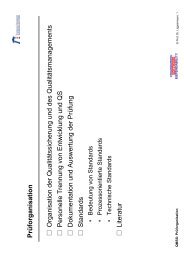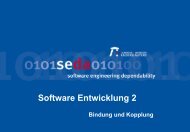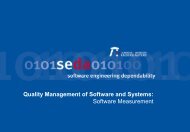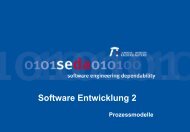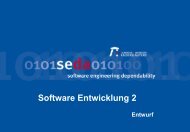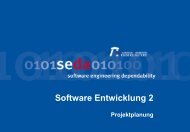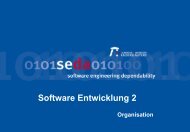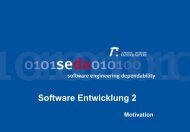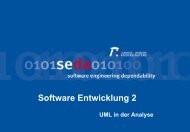The CMM and the Assessment Questions
The CMM and the Assessment Questions
The CMM and the Assessment Questions
- No tags were found...
Create successful ePaper yourself
Turn your PDF publications into a flip-book with our unique Google optimized e-Paper software.
Quality Management of Software <strong>and</strong> Systems:<br />
Software Process <strong>Assessment</strong>s
QMSS – Software Process <strong>Assessment</strong>s<br />
© Prof. Dr. Liggesmeyer<br />
Contents<br />
• Temporal development of <strong>the</strong> <strong>CMM</strong> <strong>and</strong> <strong>the</strong> assessment procedures<br />
• Mature <strong>and</strong> Immature Processes<br />
• Structure of <strong>the</strong> Capability Maturity Model<br />
• <strong>The</strong> <strong>CMM</strong> <strong>and</strong> <strong>the</strong> assessment questions<br />
• <strong>Assessment</strong> execution as a basis for process improvement<br />
• State of <strong>the</strong> practice<br />
• Costs <strong>and</strong> benefits of assessments<br />
• Problem areas of <strong>the</strong> <strong>CMM</strong> <strong>and</strong> <strong>the</strong> assessments<br />
• <strong>CMM</strong>I<br />
• Summary<br />
2
Software Process <strong>Assessment</strong>s<br />
• Motivation<br />
• evaluation of providers: not <strong>the</strong> cheapest competitor is <strong>the</strong> best choice but <strong>the</strong> one with <strong>the</strong> best<br />
cost/performance ratio<br />
• Required<br />
• procedure for <strong>the</strong> evaluation of <strong>the</strong> capability SEI-assessment<br />
• reference model as measurement st<strong>and</strong>ard for comparison Capability Maturity Model (<strong>CMM</strong>)<br />
• Entered fur<strong>the</strong>r application areas<br />
• proof of qualification marketing criterion<br />
• instrument for <strong>the</strong> targeted improvement of <strong>the</strong> SW-development process: target <strong>and</strong> priority<br />
determination<br />
• Execution<br />
• evaluation with <strong>the</strong> aid of a questionnaire (assessment)<br />
3<br />
QMSS – Software Process <strong>Assessment</strong>s<br />
© Prof. Dr. Liggesmeyer
Temporal Development of <strong>the</strong> <strong>CMM</strong><br />
<strong>and</strong> <strong>the</strong> <strong>Assessment</strong> Procedure<br />
QMSS – Software Process <strong>Assessment</strong>s<br />
© Prof. Dr. Liggesmeyer<br />
• 1987: first assessment questionnaire of Software Engineering Institute of <strong>the</strong><br />
Carnegie Mellon University on behalf of <strong>the</strong> Department of Defense<br />
• 1991: Capability Maturity Model (<strong>CMM</strong>), Version 1.0, published by SEI as<br />
reference model for evaluation procedures<br />
• 1992: <strong>Assessment</strong> questionnaire as a result of <strong>the</strong> ESPRIT project<br />
BOOTSTRAP<br />
• 1993: Capability Maturity Model, Version 1.1 published by SEI<br />
• In <strong>the</strong> future: creation <strong>and</strong> establishment of a flexible st<strong>and</strong>ard which integrates<br />
existing assessment procedures (SEI, Bootstrap, STD, Healthcheck, Trillium, ...)<br />
<strong>and</strong> related approaches (ISO 9001, Malcolm Baldridge, ...): SPICE<br />
4
QMSS – Software Process <strong>Assessment</strong>s<br />
© Prof. Dr. Liggesmeyer<br />
Mature <strong>and</strong> Immature Processes<br />
Low stage of maturity<br />
Improvised process, not always<br />
realized<br />
Reaction with problems<br />
Costs projections <strong>and</strong> schedules<br />
are normally not met<br />
Functionality <strong>and</strong> quality<br />
reduction with time problems<br />
QS-activities are not executed<br />
when time problems occur<br />
High stage of maturity<br />
Appropriate, lived process<br />
Avoidance of problems<br />
Better planning due to<br />
appropriate prognosis/projection<br />
methods<br />
Problems are prognosticated<br />
early <strong>and</strong> avoided<br />
<strong>The</strong> process is enhanced<br />
continuously<br />
5
Structure of <strong>the</strong> Capability Maturity Models<br />
Five Levels of <strong>the</strong> <strong>CMM</strong><br />
QMSS – Software Process <strong>Assessment</strong>s<br />
© Prof. Dr. Liggesmeyer<br />
Level<br />
Process characteristics<br />
5: Optimizing<br />
<strong>The</strong> process improvement is an<br />
activity executed continuously<br />
quality,<br />
productivity<br />
4: Managed<br />
<strong>The</strong> product <strong>and</strong> <strong>the</strong> process are<br />
under quantitative control<br />
3: Defined<br />
<strong>The</strong> technical procedures are institutionalized<br />
toge<strong>the</strong>r with <strong>the</strong> Project Management Practices<br />
2: Repeatable<br />
<strong>The</strong> Project Management Practices<br />
are institutionalized<br />
1: Initial Informal ad hoc process<br />
risk<br />
6
Structure of <strong>the</strong> Capability Maturity Models<br />
Effects of <strong>the</strong> <strong>CMM</strong> Levels<br />
QMSS – Software Process <strong>Assessment</strong>s<br />
© Prof. Dr. Liggesmeyer<br />
Level<br />
Prognosis quality<br />
Technique/method<br />
People<br />
5: Optimizing<br />
4: Managed<br />
3: Defined<br />
2: Repeatable<br />
1: Initial<br />
Techniques <strong>and</strong><br />
process support<br />
each o<strong>the</strong>r<br />
Quantitative basis<br />
for techniques<br />
exists<br />
Qualitative basis<br />
for techniques<br />
exists<br />
Techniques<br />
support<br />
some activities<br />
Introduction of new<br />
techniques is<br />
risky<br />
Problems are<br />
prevented, assistants<br />
improve actively<br />
Comprehension of<br />
interrelations<br />
exists<br />
Process is defined,<br />
assistants know <strong>and</strong><br />
follow it<br />
Experienced assistants<br />
keep <strong>the</strong> process<br />
alive<br />
Regular chaos<br />
elimination, low<br />
efficiency<br />
7
QMSS – Software Process <strong>Assessment</strong>s<br />
© Prof. Dr. Liggesmeyer<br />
Structure of <strong>the</strong> Capability Maturity Models<br />
• Key indicator C: Is tested in <strong>the</strong> form of a question!<br />
activities<br />
Maturity Level<br />
goals<br />
8
QMSS – Software Process <strong>Assessment</strong>s<br />
© Prof. Dr. Liggesmeyer<br />
<strong>The</strong> <strong>CMM</strong> <strong>and</strong> <strong>the</strong> <strong>Assessment</strong> <strong>Questions</strong><br />
• Are test cases submitted to formal reviews<br />
Test Adequacy<br />
SW Product<br />
Engineering<br />
Practice C<br />
Review of test<br />
plans, test<br />
procedures <strong>and</strong><br />
test<br />
Key<br />
cases<br />
Practice B<br />
Priority of<br />
critical<br />
components<br />
Criteria<br />
fulfilled<br />
Peer<br />
Reviews<br />
Database<br />
Planning<br />
Effective test<br />
<strong>and</strong><br />
techniques<br />
documentation<br />
Maturity Level: 3<br />
Maturity Level: 2<br />
Maturity Level: 1<br />
Training<br />
Training<br />
database<br />
Training for<br />
<strong>the</strong> project<br />
Training<br />
plan revised<br />
Training plan<br />
established<br />
9
QMSS – Software Process <strong>Assessment</strong>s<br />
© Prof. Dr. Liggesmeyer<br />
Key Process Areas of <strong>the</strong> <strong>CMM</strong><br />
5 Defect Prevention, Process Change Management, Technology<br />
Innovation<br />
4 Process Measurement <strong>and</strong> Analysis, Quality Management<br />
3 Process Focus, Process Definition, Training, Integrated SW<br />
Management, Product Engineering, Intergroup Coordination,<br />
Peer Reviews<br />
2 Requirements Management, Quality Assurance, Project<br />
Tracking <strong>and</strong> Oversight, Project Planning, Subcontract<br />
Management, Configuration Management<br />
1 None<br />
10
<strong>Assessment</strong> as a Basis for Process<br />
Improvement<br />
• <strong>The</strong> mechanical ticking of <strong>the</strong> questionnaire is no appropriate procedure for <strong>the</strong><br />
execution of an assessment<br />
• An assessment requires preparation<br />
• It is useful to evaluate <strong>the</strong> process definition as well as <strong>the</strong> realization in practice<br />
• Representatives of <strong>the</strong> management, development, quality assurance etc. should be surveyed<br />
• <strong>The</strong> survey should be done in <strong>the</strong> form of an open interview. <strong>The</strong> sole answering of <strong>the</strong> questions<br />
leads to unreliable, incomplete results<br />
• <strong>The</strong> evaluations of <strong>the</strong> questions have to be discussed with <strong>the</strong> interviewed persons to avoid<br />
misunderst<strong>and</strong>ings<br />
• Preparation<br />
• Inform <strong>the</strong> relevant people about <strong>CMM</strong>, assessments <strong>and</strong> <strong>the</strong>ir role<br />
• If necessary thorough training of persons of <strong>the</strong> concerned organizational unit<br />
• Create atmosphere of trust<br />
11<br />
QMSS – Software Process <strong>Assessment</strong>s<br />
© Prof. Dr. Liggesmeyer
<strong>Assessment</strong> as a Basis for Process<br />
Improvement<br />
• Execution<br />
• Survey of different groups of persons (management, developers, QS)<br />
• Evaluation of <strong>the</strong> process description (projects) <strong>and</strong> <strong>the</strong> actual situation<br />
• Ask open questions: How is <strong>the</strong> quality <strong>and</strong> applicability of <strong>the</strong> test cases determined Instead of:<br />
Are test cases submitted to formal reviews<br />
• Evaluation of <strong>the</strong> questions due to <strong>the</strong> answers to <strong>the</strong> open questions, if necessary ask additional<br />
questions<br />
• Rough taking of notes of essential statements as important information for <strong>the</strong> strengths <strong>and</strong><br />
weaknesses profile <strong>and</strong> as a basis for proposals of improvements<br />
• Discussion of <strong>the</strong> questions evaluation with <strong>the</strong> interviewed persons immediately afterwards to avoid<br />
misunderst<strong>and</strong>ings: I have evaluated <strong>the</strong> question “Are test cases submitted to formal reviews” with<br />
no because ... Did I underst<strong>and</strong> you right<br />
• Wrap-up<br />
• Show state of <strong>the</strong> process definition, <strong>the</strong> realization of this definition <strong>and</strong> <strong>the</strong> improvement potential<br />
• Determine detailed strengths <strong>and</strong> weaknesses profile according to <strong>the</strong>me complexes (e.g.<br />
development phases)<br />
12<br />
QMSS – Software Process <strong>Assessment</strong>s<br />
© Prof. Dr. Liggesmeyer
<strong>Assessment</strong> as a Basis for Process<br />
Improvement Measures for Improvements<br />
QMSS – Software Process <strong>Assessment</strong>s<br />
© Prof. Dr. Liggesmeyer<br />
• Formulation of a detailed catalogue of<br />
measures <strong>and</strong> a plan for <strong>the</strong> introduction<br />
• Installation of a competent Process<br />
Improvement Team which coordinates <strong>the</strong><br />
realization of measures<br />
• Revision of measures in teams with<br />
technical <strong>and</strong> applied knowledge (e.g.<br />
specialist for software testing with<br />
competent testers)<br />
• Support concerning <strong>the</strong> realization of<br />
measures<br />
• Show successes<br />
• Ensure realistic expectations: successful<br />
improvements require time as well as<br />
financial <strong>and</strong> personal costs<br />
process (old)<br />
target values:<br />
• quality<br />
• efficiency<br />
• …<br />
process (new)<br />
process modification<br />
assessment<br />
strength <strong>and</strong><br />
weakness profile<br />
catalogue of<br />
measures<br />
maturity<br />
level<br />
<strong>CMM</strong><br />
process improvement<br />
evaluation or<br />
improvement activities<br />
13
State of <strong>the</strong> Practice<br />
Maturity Level of US-Companies<br />
QMSS – Software Process <strong>Assessment</strong>s<br />
© Prof. Dr. Liggesmeyer<br />
74<br />
sources:<br />
/Humphrey et al. 89/<br />
%<br />
60<br />
40<br />
20<br />
43,2<br />
24,8<br />
6,3<br />
41,7<br />
39,9<br />
34,2<br />
22<br />
34,2<br />
23,8<br />
17,3<br />
4<br />
SEI, Carnegie Mellon University:<br />
maturity levels of 734 organizations<br />
from 1995 to 1999 (internet)<br />
SEI, Carnegie Mellon University:<br />
maturity levels of 1158 organizations<br />
from 1997 to 2002 (internet)<br />
SEI, Carnegie Mellon University:<br />
maturity levels of 1613 organizations<br />
from 2001 to 2005 (internet)<br />
8,1<br />
9,8<br />
6<br />
4,0 5,5<br />
1,4<br />
1 2 3 4 5<br />
maturity level<br />
14
Costs <strong>and</strong> Benefit of <strong>Assessment</strong>s<br />
• Hughes Aircraft (IEEE Software, July 1991)<br />
• 1987: level 2 after assessment improvement on level 3 (1990)<br />
• Costs of <strong>the</strong> <strong>Assessment</strong>s: 45,000 US $<br />
• Costs for two years process improvement: 400.000 US $<br />
• Caused annual savings/reduction of costs: approx. 2,000,000 US $<br />
• Ray<strong>the</strong>on (IEEE Software, July 1993)<br />
• Process improvement from level 1 (beginning of 1988) to level 3 (end of 1991)<br />
• Return on Investment factor: 7.7<br />
• Double productivity<br />
15<br />
QMSS – Software Process <strong>Assessment</strong>s<br />
© Prof. Dr. Liggesmeyer
Problem Areas of <strong>the</strong> <strong>CMM</strong> <strong>and</strong> <strong>the</strong><br />
<strong>Assessment</strong>s<br />
QMSS – Software Process <strong>Assessment</strong>s<br />
© Prof. Dr. Liggesmeyer<br />
• No guaranteed interrelation between high <strong>CMM</strong>-level <strong>and</strong> successful software<br />
production<br />
• Ra<strong>the</strong>r technology-oriented than staff oriented<br />
• Weak in level 4 <strong>and</strong> 5 (few assured findings)<br />
• <strong>The</strong> interrelation between <strong>the</strong> questionnaire <strong>and</strong> <strong>the</strong> <strong>CMM</strong> is not always visible<br />
• Model prescribes certain activities independently of <strong>the</strong>ir utility. Experiences<br />
concerning successes are not considered<br />
• To reach a high level it is necessary to meet all requirements of <strong>the</strong> lower levels<br />
• Not optimally appropriate for technical application areas<br />
16
QMSS – Software Process <strong>Assessment</strong>s<br />
© Prof. Dr. Liggesmeyer<br />
<strong>CMM</strong> - Summary<br />
• It may be expected that <strong>the</strong> <strong>CMM</strong> provides a systematic opportunity for <strong>the</strong><br />
increase of quality <strong>and</strong> productivity in <strong>the</strong> software development<br />
• By applying process assessments, <strong>the</strong> gaps that need improvement are found<br />
• Some published surveys show a good costs-benefit balance<br />
• Many companies concentrating on tool <strong>and</strong> technology activities have neglected<br />
<strong>the</strong> process. Here a potential for improvements exists<br />
• <strong>The</strong> <strong>CMM</strong> <strong>and</strong> <strong>the</strong> assessment methodology have to be improved in some<br />
essential parts <strong>and</strong> for particular application areas. Activities with this aim are<br />
executed<br />
17
<strong>CMM</strong>I<br />
• <strong>The</strong> Capability Maturity Model Integration is <strong>the</strong> result of an enhancement made<br />
to <strong>the</strong> <strong>CMM</strong> in 2008.<br />
• <strong>The</strong> purpose was to develop a framework supporting a set of integrated models:<br />
• Model dedicated to <strong>the</strong> software development processes (<strong>CMM</strong>I-DEV 1.2)<br />
• Model for <strong>the</strong> acquisition of software (<strong>CMM</strong>I-ACQ 1.2)<br />
• Model focusing on services (<strong>CMM</strong>I_SVC 1.3)<br />
• <strong>The</strong> <strong>CMM</strong>I differentiates 22 process areas, which are divided into 4 groups:<br />
• Project Management<br />
• Engineering<br />
• Process Management<br />
• Support<br />
18<br />
QMSS – Software Process <strong>Assessment</strong>s<br />
© Prof. Dr. Liggesmeyer
<strong>CMM</strong>I<br />
• Each <strong>CMM</strong>I process area describes goals that should be achieved:<br />
• Specific Goals: describe what should be done to satisfy a specific process area. Should be<br />
achieved by conducting <strong>the</strong> processes related to this process area.<br />
• Generic Goals: are universally defined goals that apply to all process areas.<br />
• <strong>The</strong> <strong>CMM</strong>I has two representations:<br />
• Continuous: any process area can be evaluated:<br />
• A capability level for this process area is determined<br />
• <strong>The</strong>re are 6 capability levels: “0: Incomplete”, “1: Performed”, “2: Managed”, “3: Defined”, “4:<br />
Quantitatively Managed”, “5: Optimizing”<br />
• <strong>The</strong> result of <strong>the</strong> assessment is a comb-shaped profile of <strong>the</strong> process<br />
• Staged: <strong>the</strong> complete organization is evaluated:<br />
• A maturity level is assigned to <strong>the</strong> organization.<br />
• <strong>The</strong>re are 5 maturity levels: “1: Initial”, “2: Managed”, “3: Defined”, “4: Quantitatively Managed”,<br />
“5: Optimizing”<br />
• To achieve a maturity level, an organization has to determine if <strong>the</strong> process areas<br />
corresponding to this level fulfill a predefined capability level.<br />
19<br />
QMSS – Software Process <strong>Assessment</strong>s<br />
© Prof. Dr. Liggesmeyer
QMSS – Software Process <strong>Assessment</strong>s<br />
© Prof. Dr. Liggesmeyer<br />
Literature<br />
• <strong>CMM</strong>I: http://www.sei.cmu.edu/cmmi/<br />
• Rout T.P., SPICE: A Framework for Software Process <strong>Assessment</strong>, in: Software<br />
Process - Improvement <strong>and</strong> Practice, Vol. 1, No. 1, August 1995, pp. 57-66<br />
• SPICE: ISO/IEC 15504<br />
20



